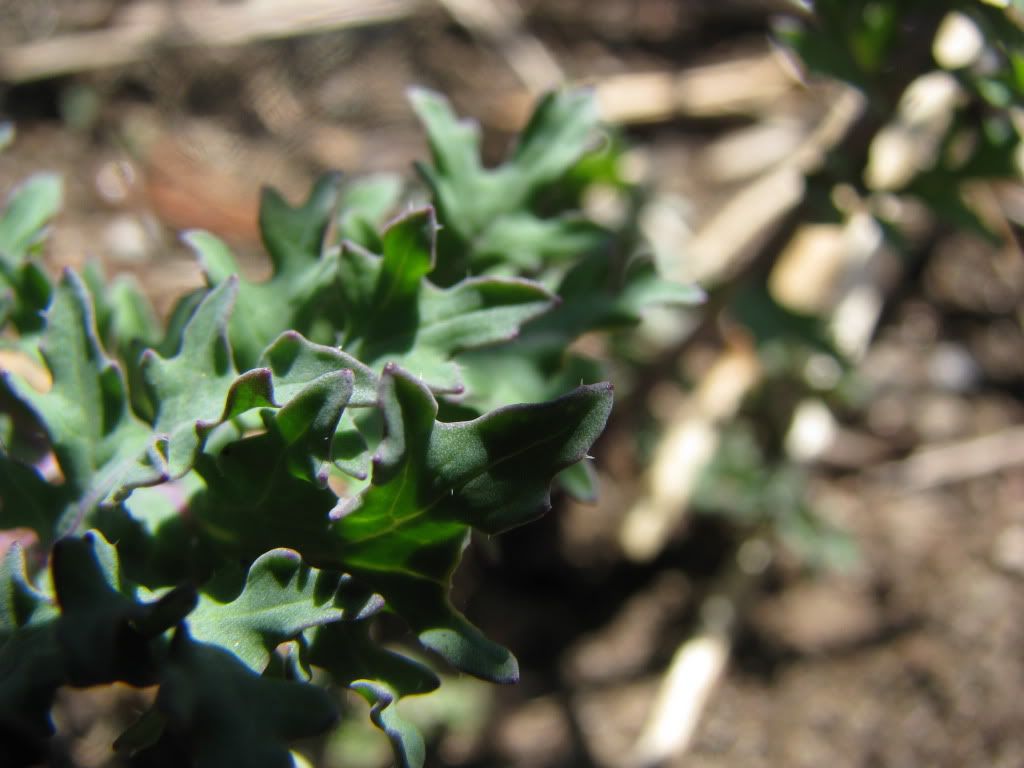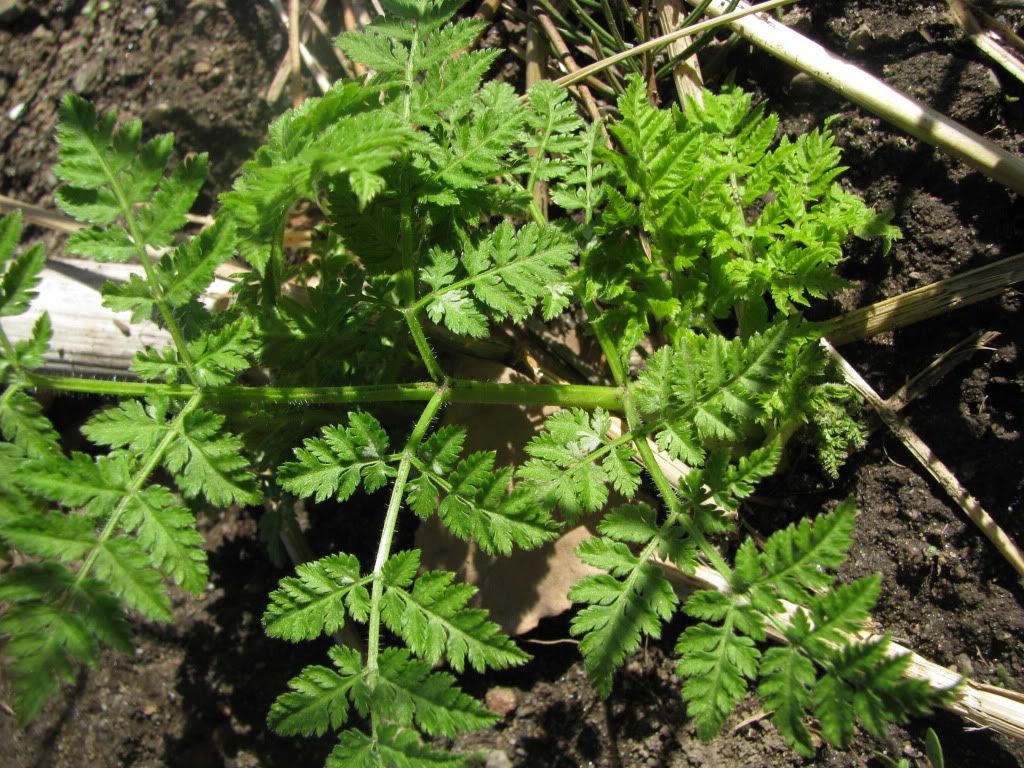
Red Ursa Kale overwintered from seedling taken from my last place.
As you wander around your spring garden admiring daffodiles and shoots promising to be peony, hosta or daylily, you may also notice that some of your veggies survived. Some of these may be biennials that wait patiently until after the big chill to flower such as kale or beets. They might be perennials that grow fat little rosettes the first year like chicory or even an annual that you seeded late like lettuce. If you have room, let those little guys do what they do best, grow much bigger.
Staying your hand at weeding means that you have given them a chance to seed. If the population is big enough then you'll have a viable seed crop to sow or trade but saving once from a small population may allow you to select for a special characteristic like cold hardiness. Besides, some make great spices like caraway or mustard and delicious sprouts like onion and chard. It is not just you who will enjoy them in their full flowering glory. Many are nectar sources for beneficials that will help keep pests in check.

Sweet Cicely, a perennial member of the carrot family that thrives in dappled shade and tastes great like sugar coated anise from root to seed.
A list of treasures that may be waiting to regrow in your garden:
Alliums (Alliaceae):
- Onions - Biennial. Let lots go to flower for good for good seed. Many alliums make yummy sprouts.
- Leeks - Also, biennial and produce offsets at the base of the bulb that can be replanted.
- Garlic - I always manage to find a few bulbs that I overlooked. Bulbing perennial. Topsetting bulbils can be harvested, and scapes are delicious. Let them grow through the year and you'll get a handfull of mini bulbs for replanting. You can also start garlic from the bulbils though it takes a few years to get full sized bulbs.
- Of course, lots of perennials like garlic chives, regular chives, multipliers, shallots and walking onion
Goosefoot (Chenopodiaceae):
- Beets & Chard- Biennial, makes nice baby greens or sprouts, huge sprawling seed stalks benefit from caging. They are wind pollinated and will cross with each other. Bientina has overwintered particularly well for me.
- Spinach - Sexing is complex apparently so make sure you have a couple dozen will be needed for good seed set. I have so many spinach substitutes in the garden I rarely grow it.
- Perennials like Good King Henry, Sorrel and Bloody Dock will be producing crispy greens right now.
Asters (Compositaceae):
- Radicchio, Beligium Endive, Sugarloaf Chicory - Perennial, all C. intybus. Tall 'chicory' seedheads. Endive is an annual C. endivia and can cross according to Deppe's book***
- Lettuce - Annual, self fertile and inbreeding so technically you only need one for good seed but more is always better. Let the finches distribute the seeds or save.
Cabbage Family (Brassicaceae):
- Kale: Various species, including some that cross with Brassica oleracea, such as cabbage, and some are B. napus so will cross with other stuff like oilseed rape! They are reliable biennial returnees, especially the Russo-Siberian types, in my garden often forming a semi-feral population. Edible young seedpods, edible seeds and edible sprouts.
- Cabbage, some kinds of broccoli: Even if they look very ragged, wait to see if they perk up or leaf out again. These are outcrossers and are often self incompatible so let as many go to seed as possible. Nice sprouts.
- Chinese Greens: Lots of these are brassicas so look up the species to see who they are friendly with if you don't want crosses.
- Turnips: Mine always turn to mush but if you got yours to overwinter or are replanting the last of your cold storage roots then like most root crops aim for letting a good dozen go to seed.
Carrot Family (Apiaceae):
- Carrots of course: I get about a 50% suvival rate. You can dig these up, taste the end and replant the ones you like the best. Aim for as big a population as possible. Whether or not greens or sprouts are edible seems to depend on who you ask. If it's cottontail then the answer is yes.
- Oyster root - Salsify & Scorzonera: Not only do these seem to reliably come back but you can eat the early spring shoots then the immature flowerheads or the flowers (the former purple, the latter yellow). Scorzonera is a perennial whereas salsify is a biennial. I think the sprouts are probably edible as the greens are and this is my rule of thumb but feel free to do this search for me as I've never tried them.
- Parsnips: Some people get naturally seeding populations. Afterall, wild parsnip - pretty much the same as the domesticated variety* - is a common roadside weed.**
- Parsley: both the root and various leaf varieties are quite hardy.
- Need I say perennials again? Sweet Cicely and skirret are examples.
Notes
* A note about biennials. Sometimes they will wait until the third year or even the fourth to flower. Some will flower two years in a row despite the fact that they are supposed to die back after setting seed. Go figure.
**Always be cautious when harvesting carrot family weeds as some, like hemlock, are very deadly and others like giant hog's weed can cause serious burns.
***Carol Deppe's book Breed Your Own Vegetable Varieties can answer your pollination questions. Really well written book.***
Links
The Sprout People: Lots of info in the Sprout School section

2 comments:
In response to a WARNING I posted on a footnote about being cautious with harvesting wild carrot relatives, someone posted a gory picture of a burn from wild parsnip. In no other way did it engage with the post so I declined it. So consider youself have been double warned. Also, it wouldn't hurt to be cautious about regular parsnip foliage.
I knew a lot of the wild carrot family were poisonous, but never knew you could get burned from them. Some day I want to put in some walking onions. They would be fun to have in my herb garden.
Post a Comment